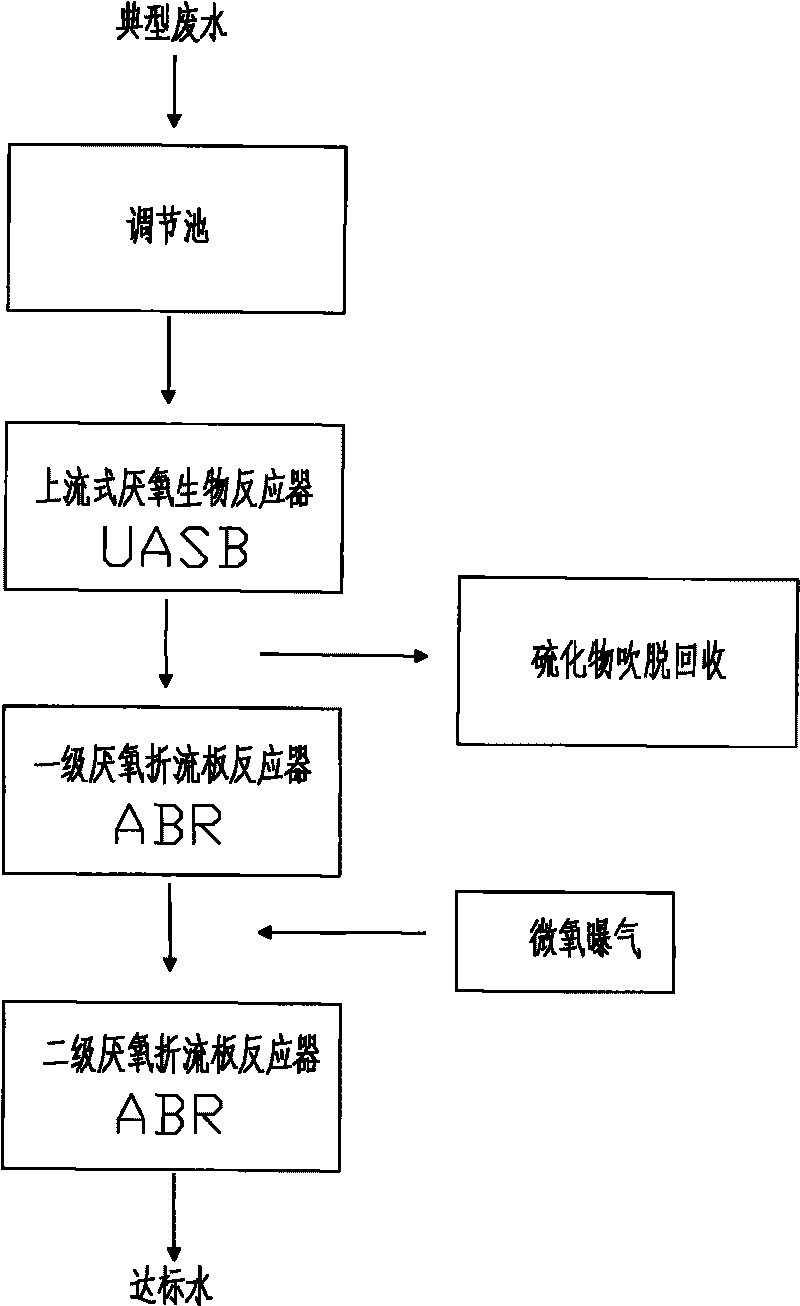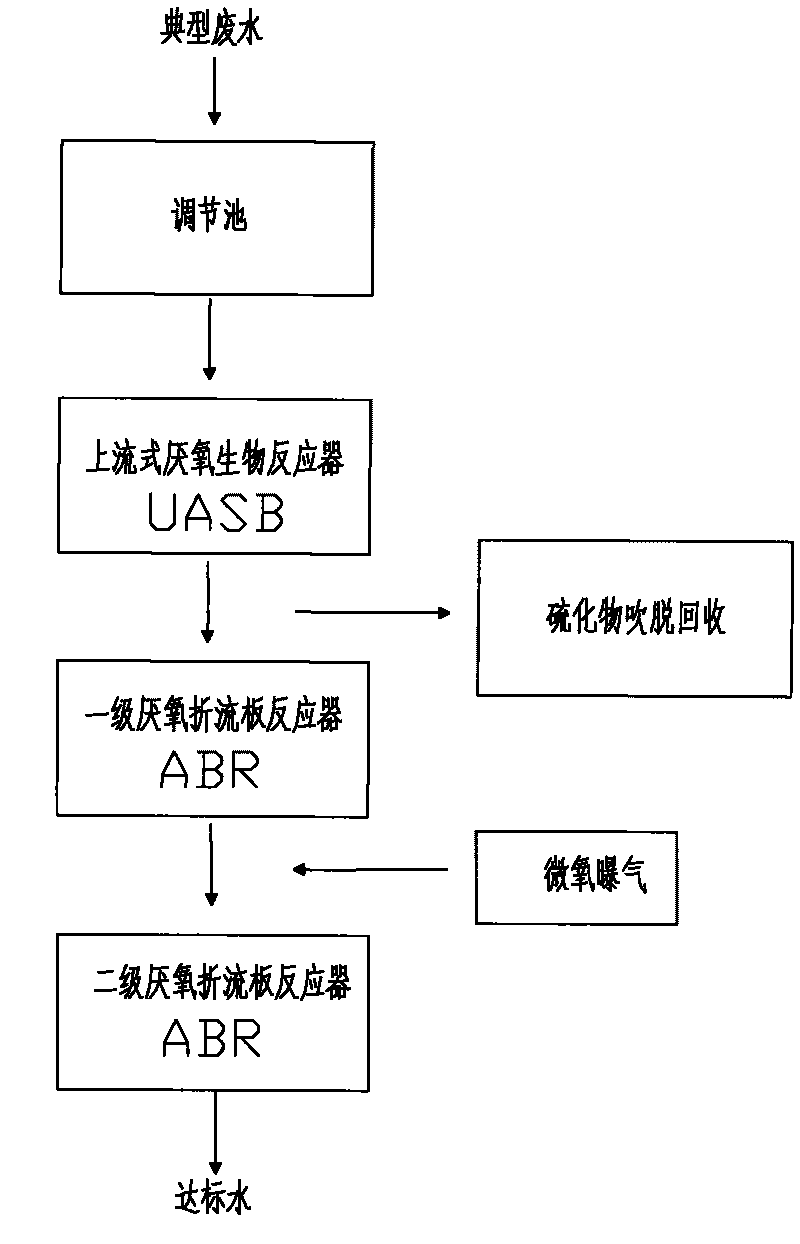Method for biologically treating wastewater by simultaneously desulfurizing, denitrifying and decoloring
A biological treatment and waste water technology, applied in biological water/sewage treatment, water/sewage multi-stage treatment, water/sludge/sewage treatment, etc., can solve the problem of high system energy consumption, high operating cost, and difficulty in meeting water quality discharge standards And other issues
- Summary
- Abstract
- Description
- Claims
- Application Information
AI Technical Summary
Problems solved by technology
Method used
Image
Examples
Embodiment 1
[0022] according to figure 1 The process shown treats tannery wastewater. By inoculating Citrobacter sp SR3 of the genus Citrobacter in the sludge of an upflow anaerobic bioreactor (UASB), the sludge is routinely domesticated to form activated granular sludge, so that the upflow anaerobic organisms The reactor (UASB) is quickly started; the sludge of the first-stage anaerobic baffle reactor (ABR) is inoculated with Shewanella decolorationis, and the sludge is routinely domesticated to form activated granular sludge , so that the first-stage anaerobic baffle reactor (ABR) can be quickly started; the sludge of the second-stage anaerobic baffle reactor (ABR) was inoculated with Brocadia anammoxidans, and the sludge was Conventional domestication, the formation of activated granular sludge, the rapid start-up of the secondary anaerobic baffle reactor (ABR).
[0023] The concentration of sulfate in the tannery industrial waste water treated in this embodiment is 300 mg / L, the con...
Embodiment 2
[0028] according to figure 1The process shown treats tannery wastewater. By inoculating Desulfovibrio desulfuricans of the genus Desulfovibrio in the sludge of an upflow anaerobic bioreactor (UASB), the sludge is routinely acclimated to form activated granular sludge to make the upflow anaerobic biological reaction Rapid start-up of the reactor (UASB); inoculation of Aeromonas hydrophila (Aeromonas hydrophila) in the sludge of the primary anaerobic baffle reactor (ABR) for routine domestication of the sludge to form activated granular sludge , so that the first-stage anaerobic baffle reactor (ABR) can be quickly started; the sludge in the second-stage anaerobic baffle reactor (ABR) was inoculated with Kuenenia stuttgartiensis, and the sludge was routinely The domestication of activated granular sludge is formed, so that the secondary anaerobic baffle reactor (ABR) can be quickly started.
[0029] The sulfate concentration of the tannery industrial wastewater treated in this ...
Embodiment 3
[0034] according to figure 1 The process shown treats tannery wastewater. By inoculating the sludge of the upflow anaerobic bioreactor (UASB) with Citrobacter sp SR3 of the genus Citrobacter, the sludge is routinely acclimated to form activated granular sludge and make the upflow anaerobic biological reaction The rapid start-up of the UASB reactor; inoculation of Shewanella decolorationis in the sludge of the first-stage anaerobic baffle reactor (ABR) for routine domestication of the sludge to form activated granular sludge, so that The primary anaerobic baffled reactor (ABR) was quickly started; the sludge in the secondary anaerobic baffled reactor (ABR) was inoculated with Brachymonas denitrificans of the genus Brachymonas, and the sludge was routinely The domestication of activated granular sludge is formed, so that the secondary anaerobic baffle reactor (ABR) can be quickly started.
[0035] The tannery industrial wastewater treated in this embodiment has a sulfate conce...
PUM
 Login to View More
Login to View More Abstract
Description
Claims
Application Information
 Login to View More
Login to View More - R&D
- Intellectual Property
- Life Sciences
- Materials
- Tech Scout
- Unparalleled Data Quality
- Higher Quality Content
- 60% Fewer Hallucinations
Browse by: Latest US Patents, China's latest patents, Technical Efficacy Thesaurus, Application Domain, Technology Topic, Popular Technical Reports.
© 2025 PatSnap. All rights reserved.Legal|Privacy policy|Modern Slavery Act Transparency Statement|Sitemap|About US| Contact US: help@patsnap.com


